"Curry Cuisine"
October 22, 2009 - Volume 1 - Issue 20
|
|
|
|
|
|
Curry Cuisine
|
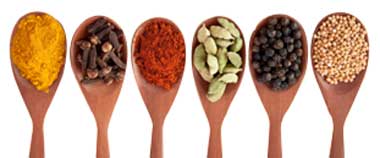
Mention
"curry" and our mouths begin to salivate. We inhale deeply in
anticipation of the rich aromas that will permeate the kitchen as the
curry develops its layers on the stove. Either mild or hot, curries are
a pillar of Indian culinary traditions. As our palates "go global" in
search of the exciting and novel, curry flavors satisfy both culinary
curiosity and gustatory satisfaction. In this issue we open the door to
just a few basics of Indian cooking techniques, ingredients, and
flavors that we think will pique your interest to learn more. We begin
with some basic answers about curry, followed by some essential
techniques. We finish with a unique cookbook that removes the "it's too
complicated" barrier that often accompanies forays into ethnic cooking
explorations. The featured book, 5 Spices, 50 Dishes,
focuses on the essence of Indian flavors by utilizing accessible
ingredients and methods; it's an excellent primer for any Westerner
desiring a global flair, or merely fabulously tasting good food!
|
Intro to Indian Cooking
|
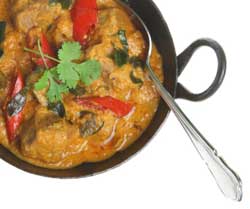 India
is a big country with many regional specialties as in our own country,
and certainly many more than one can grasp in a brief overview. The
specialties arise from the land and climate, and take advantage of the
food that flourishes best in each area. Further, India's rich history
as a melting pot of many peoples and migrations has greatly influenced
its cuisine over the centuries along with its multiple ethnic and
religious traditions. India
is a big country with many regional specialties as in our own country,
and certainly many more than one can grasp in a brief overview. The
specialties arise from the land and climate, and take advantage of the
food that flourishes best in each area. Further, India's rich history
as a melting pot of many peoples and migrations has greatly influenced
its cuisine over the centuries along with its multiple ethnic and
religious traditions.
A very broad categorization of Indian
cuisine might start with a delineation of Northern, Southern, Eastern
and Western Indian food traditions - (apologies to our Indian friends
for this simplistic explanation). Within each region are distinct
cuisines: Andhra, Bangladeshi, Bengali, Gujarati, Karnataka, Malayali,
Nepalese, Oriyas, Pashtun, Punjabi, Sindhi, Sri Lankan, Tamil, Telugu,
and on and on. As spices of the Far East headed to Europe and the New
World centuries ago, the return trip brought tomatoes, potatoes, squash
and chiles to the Indian subcontinent turning them into culinary
staples for Indian kitchens. Old and new together have created today's
unique and pleasing fusion of flavors. |
|
|
|
Three Key Questions
|
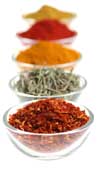 What is curry?
Just one category of Indian recipes, "curry" is actually a generic term
most easily translated as "sauce" or "gravy." From that broad
definition, the specifics explode into an array of pleasures. To our
initial frustration, there is no single list of spices or ingredients
that define "curry." Curry can refer to the spiced sauce, or to an
entire dish made with a spiced sauce. Resolution on the definition is
best reached by understanding "curry" in its broadest sense - "a spiced
dish with southern Asian origins." To confuse matters a bit more, curry
is also a plant whose leaves are often used in fresh form. Curry leaves
may be part of a curry dish, but are not responsible for the classic
taste of curries. What is curry?
Just one category of Indian recipes, "curry" is actually a generic term
most easily translated as "sauce" or "gravy." From that broad
definition, the specifics explode into an array of pleasures. To our
initial frustration, there is no single list of spices or ingredients
that define "curry." Curry can refer to the spiced sauce, or to an
entire dish made with a spiced sauce. Resolution on the definition is
best reached by understanding "curry" in its broadest sense - "a spiced
dish with southern Asian origins." To confuse matters a bit more, curry
is also a plant whose leaves are often used in fresh form. Curry leaves
may be part of a curry dish, but are not responsible for the classic
taste of curries.
What is curry powder?
- Curry powder is a spice blend that attempts to shortcut the
assemblage of spices for a curry dish. Spice purveyors mix their own
blends of curry powders. Again, there is no one list of ingredients or
proper proportions comprising curry powder. There are certain themes
across the unique blends that almost always include: turmeric, cumin,
coriander, and fenugreek, then perhaps proprietary amounts of garlic,
cloves, fennel seed, ginger, cinnamon, clove, mustard seed, cardamom,
mace, nutmeg, black pepper, red pepper, or any number of other spices.
A curry powder is handy, but obfuscates the breadth of flavors possible
in making curry dishes from individual spices according to the needs of
the specific recipe.
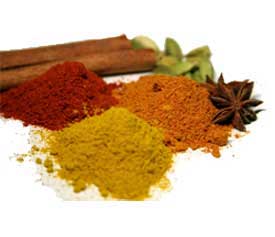 What is garam masala? A literal translation of garam masala is "hot mixture," where "hot" refers to an intensity of taste, rather than heat as produced by a chile. There are hundreds of garam masala mixtures, each unique to the cook or family tradition. A garam masala mix of spices varies regionally, but might include peppercorns, cardamom, nutmeg, cinnamon, and clove. Garam masala is usually added at the end of cooking to maximize the flavors. Unlike curry spice blends, garam masala does not commonly feature turmeric, coriander, fenugreek, or mustard seed to the extent that curry powder does. Garam masala has distinct uses in both its roasted and unroasted forms. What is garam masala? A literal translation of garam masala is "hot mixture," where "hot" refers to an intensity of taste, rather than heat as produced by a chile. There are hundreds of garam masala mixtures, each unique to the cook or family tradition. A garam masala mix of spices varies regionally, but might include peppercorns, cardamom, nutmeg, cinnamon, and clove. Garam masala is usually added at the end of cooking to maximize the flavors. Unlike curry spice blends, garam masala does not commonly feature turmeric, coriander, fenugreek, or mustard seed to the extent that curry powder does. Garam masala has distinct uses in both its roasted and unroasted forms.
In
addition to key spices, flavor-filled fresh herbs and vegetables
underpin many curry recipes, especially onion, garlic, ginger and fresh
chiles. The spices and aromatics combined with oils, coconut milk, or
vegetable liquids form the curry sauce that deliciously coats
vegetables, legumes, meats, or poultry.
|
Curry Techniques
|
Most
Indian cookery is accomplished on the stovetop with very little use of
the oven. It holds many similarities to wok cookery in that regard. The
techniques of Indian cooking focus on the layering of flavors and the
optimization of each ingredient. This is most obvious with the
preparation of spices:
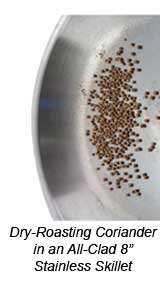 Dry-roasting of Spices
- Many Indian recipes call for the roasting of spices. Like nuts, many
whole seed spices such as coriander, cumin, fenugreek, and others,
benefit from roasting; the flavors are brought forth and the golden
toast transforms and deepens the inherent flavors. To dry roast spices,
use a small, heavy-bottomed skillet. Heat the pan over medium high
heat. Add the seeds and stir frequently to achieve even browning. The
color of the seeds will deepen and exude their aroma. If you
"over-roast" the spices (a.k.a. "burn") throw out that batch and start
over! Dry-roasting of Spices
- Many Indian recipes call for the roasting of spices. Like nuts, many
whole seed spices such as coriander, cumin, fenugreek, and others,
benefit from roasting; the flavors are brought forth and the golden
toast transforms and deepens the inherent flavors. To dry roast spices,
use a small, heavy-bottomed skillet. Heat the pan over medium high
heat. Add the seeds and stir frequently to achieve even browning. The
color of the seeds will deepen and exude their aroma. If you
"over-roast" the spices (a.k.a. "burn") throw out that batch and start
over!
Oil-roasting of Spices
- Some spices respond to hot oil with a special blooming of their
flavors, especially coriander, cumin, fenugreek, and peppercorns. This
process of oil-roasting is known as tadka or tarka. Heat a high temperature-tolerant oil such as canola or peanut oil in a high quality skillet. 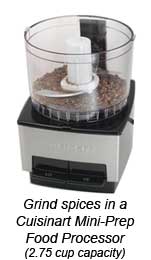 Test
the heat of the oil with a drop of water. When the droplet sizzles and
skips, add the seeds. They too will sizzle and spatter as they quickly
roast. (A splatter screen is very useful at this moment!) Watch very
carefully as the seeds will brown quickly. Remove the pan from heat and
transfer the seeds to a small plate lined with a paper towel. Once
cooled, grind the spices and proceed with your recipe. Test
the heat of the oil with a drop of water. When the droplet sizzles and
skips, add the seeds. They too will sizzle and spatter as they quickly
roast. (A splatter screen is very useful at this moment!) Watch very
carefully as the seeds will brown quickly. Remove the pan from heat and
transfer the seeds to a small plate lined with a paper towel. Once
cooled, grind the spices and proceed with your recipe.
Grinding Spices
- As with all spices, buy small quantities that will be used within a
relatively short time period. Store them in a dark, dry location in
your kitchen. Whole spices hold their flavor longer and with greater
potency than ground or powdered spices. In Indian cooking, whole spices
are frequently preferred for the added flavor yielded in the roasting
step. Whole spices are roasted then ground just as they are needed in
the recipe. Spices may be ground with a mini food processor, mortar and
pestle, a coffee grinder, or a mechanical spice grinder.
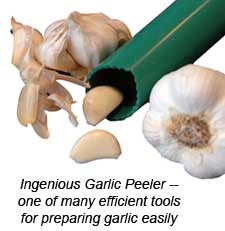
Aromatic Roots - Onion, Garlic, Ginger - Many, many Indian dishes begin with a diced onion quickly followed by a paste of garlic and ginger.
- Onion Dicing
- a sharp knife and cutting board are tried and true, but you might
like to experiment with other onion tools that dice whole onions with
one motion.
- Garlic Prep
- With the too-simple-to-believe garlic peeler and twisting garlic
mincer, preparing larger quantities of garlic is easy and quick.
- Ginger - Use a ginger grater or a microplane to zest peeled ginger into a pulp while leaving behind the stringy fibers.
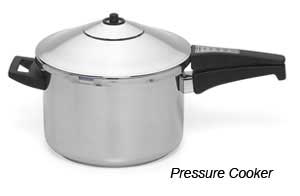 Pressure-cooking for Legumes and Meats
- Modern day Indian cooking often deploys a pressure cooker to make
quick work of stewing meats and cooking dried legumes. Unlike your
mother's pressure cooker, today's pots are safe and a true time saver.
The two hours it previously took to soak and cook lentils or split peas
now consumes a total of 15 minutes with the help of a pressure cooker.
You'll quickly find that your pressure cooker is your new favorite pot
-- Indian dishes are but one use for this re-engineered time saver. Pressure-cooking for Legumes and Meats
- Modern day Indian cooking often deploys a pressure cooker to make
quick work of stewing meats and cooking dried legumes. Unlike your
mother's pressure cooker, today's pots are safe and a true time saver.
The two hours it previously took to soak and cook lentils or split peas
now consumes a total of 15 minutes with the help of a pressure cooker.
You'll quickly find that your pressure cooker is your new favorite pot
-- Indian dishes are but one use for this re-engineered time saver. |
Curry Companions
|
Integrating
a curry dish into your menu can be accomplished as an eclectic event,
or as part of a themed meal with traditional accompaniments.
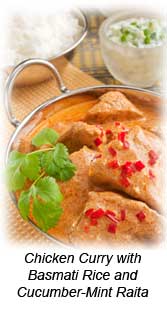 Curry over Rice - A classic presentation of a curry dish is where the sauce is ladled over a bed of rice. Basmati rice
is the choice for Indian dishes. Basmati rice is a long-grained rice
with a wonderful fragrance when cooking and a distinctive, nutty flavor
when eaten. Available in both white and brown forms, basmati rice cooks
up as separate, individual grains. Rice may be steamed on the stovetop
or in a rice cooker. Biryani,
a whole category of spiced, rice-based Indian dishes, goes well with
curry dishes and is another topic to explore as you try your hand at
Indian cooking. Curry over Rice - A classic presentation of a curry dish is where the sauce is ladled over a bed of rice. Basmati rice
is the choice for Indian dishes. Basmati rice is a long-grained rice
with a wonderful fragrance when cooking and a distinctive, nutty flavor
when eaten. Available in both white and brown forms, basmati rice cooks
up as separate, individual grains. Rice may be steamed on the stovetop
or in a rice cooker. Biryani,
a whole category of spiced, rice-based Indian dishes, goes well with
curry dishes and is another topic to explore as you try your hand at
Indian cooking.
Indian Breads - Reliant primarily on stovetop cooking, Indian breads such as chapatti, poori, naan, and roti,
are cooked on griddles and skillets in quick flatbread fashion. Torn
portions of the bread are used to scoop up the curry. You'll love
experimenting with Indian breads along with investigating curries.
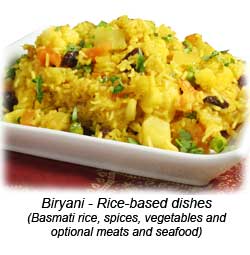 Raita (raithas) - Hot, spicy dishes call for relief occasionally. Chilled Indian raitas
offer a respite with their yogurt-based dressing. Yogurt, plain and
unsweetened, is a staple of Indian cuisine. Finely diced cucumbers,
onions and other vegetables are added to the yogurt along with, of
course, a few spices. Raita (raithas) - Hot, spicy dishes call for relief occasionally. Chilled Indian raitas
offer a respite with their yogurt-based dressing. Yogurt, plain and
unsweetened, is a staple of Indian cuisine. Finely diced cucumbers,
onions and other vegetables are added to the yogurt along with, of
course, a few spices.
Chutneys/Pickles
- Among our favorite components of an Indian meal are chutneys and
pickles. Chutneys - loosely akin to salsas - might be for dipping or
drizzling. They are an essential side dish and complement to an Indian
meal. Indian pickles, another side dish, can be made of any number of
fruits or vegetables marinated in oil, lemon juice, and spices.
|
Smart Indian Cooking Tips
|
Tip #1: If you're seeking to incorporate more plant-based menus in your diet, Indian cuisine is a natural source of inspiration. It's
reported that less than 30% of Indians are regular meat eaters. You'll
find many delicious recipes that will enhance and expand your enjoyment
of all kinds of fruits and vegetables with Indian cooking.
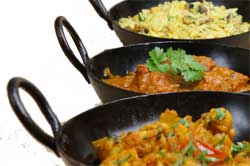 Tip #2:
Shop at health food/natural food stores or ethnic food aisles for some
of the ingredients required in more complicated Indian recipes. But
don't let unfamiliar ingredients hinder your explorations! As noted in
the cookbook reviewed below, many delicious Indian flavors and great
dishes are available with commonly available ingredients. Tip #2:
Shop at health food/natural food stores or ethnic food aisles for some
of the ingredients required in more complicated Indian recipes. But
don't let unfamiliar ingredients hinder your explorations! As noted in
the cookbook reviewed below, many delicious Indian flavors and great
dishes are available with commonly available ingredients.
Tip #3: Ghee is a common ingredient in Indian cooking and easily available in jarred form. Ghee is butter that has been clarified and "toasted," and has a very concentrated butter flavor. To make your own ghee, melt butter at a medium temperature until foaming occurs and the white milk solids separate from the oil. Skim away the foam. Allow the butter to continue heating until the white 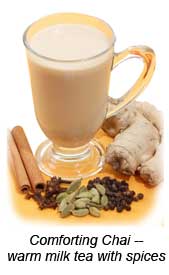 milk solids turn a golden brown; monitor carefully during this stage. The process steams away any water present in the butter. Strain away the browned particles reserving the clear oil. Ghee
may be stored at room temperature for up to six months and in the
refrigerator for up to a year. Use as you would any flavorful oil, not
just in Indian cooking. milk solids turn a golden brown; monitor carefully during this stage. The process steams away any water present in the butter. Strain away the browned particles reserving the clear oil. Ghee
may be stored at room temperature for up to six months and in the
refrigerator for up to a year. Use as you would any flavorful oil, not
just in Indian cooking.
Tip #4:
Curry is not restricted to Indian dishes, Thai curries and Vietnamese
curries share the same "spiced sauce" definition, but with their own
regional twist. Thai curries often begin with curry pastes based on
red, green, or yellow chiles and developed with unique blends of spices
and herbs. Vietnamese curries are thinner in consistency than most
Indian curries.
Tip #5: Enjoy Indian spice flavors with a warm chai. A mix of sweetened milk and tea is steeped with spices, (cinnamon, cardamom, cloves and other variations). Many find drinking chai to be a very soothing, relaxing experience with positive health effects.
|
Q & A's
|

Q: What is coconut milk?
A:
Coconut milk is the liquid contained in the pulp of a coconut. Once
opened, the white portion of the coconut is grated with a coconut
grater, or the "white meat" chunks are removed and processed to a pulp
in a food processor. The
pulp is squeezed dry with the juices - the coconut milk - saved. The
water in the center of a coconut is known as coconut water and may be
used in cooking, but is not the milk and not very flavorful. Coconut
milk is also available in most supermarkets along with other ethnic
foods. It's important to distinguish canned coconut milk from canned
crème de coconut which is sweetened and not suitable for most curry
recipes.
Q: What is vindaloo?
A:
A vindaloo is a common Indian entrée typically with some red chile fire
power. Traditional vindaloos are made with pork and stem from
Portuguese traditions. Modern vindaloos may replace pork with chicken,
beef, or lamb, and often include potatoes. A type of curry, a vindaloo
has a vinegar component along with a fiery spice mixture. The meat in a
vindaloo is frequently marinated in the spice mixture for extra flavor
enhancement.
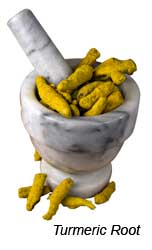 Q: What is turmeric? Q: What is turmeric?
A:
Turmeric is a common Indian spice made from a rhizome (root stem) and
is related to ginger. The roots are boiled, dried, and powdered. India
produces and consumes the majority of the turmeric crop. Turmeric is
responsible for the intense yellow color of most curries and is a
common thread across the many curry variations. Take care when using
turmeric as it easily stains clothing, countertops, and porous utensils
a lovely yellow color. The yellow of the stain is dissolvable with
alcohol or oil. The ultra-violet component of sunlight will also help
to remove stains from clothing.
Q: What are pulses?
A:
Pulses are a common Indian term for legumes of all types. With the
heavy emphasis on vegetarian eating in Indian, pulses are an important
nutritional component of the diet. Pulses include red lentils, brown
lentils, yellow and green split peas, chickpeas and beans of all types.
Preparations of pulses are often termed "dals," or "daals."
|
|
Cookbook Review
|
5 Spices, 50 Dishes, Simple Indian Recipes using Five Common Spices by Ruta Kahate. Photography by Susie Cushner. Copyright 2007. Published by Chronicle Books, San Francisco, CA.
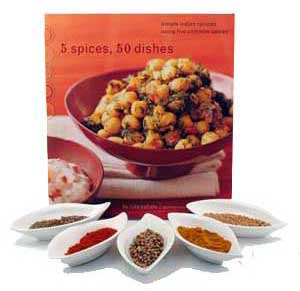 A
perfect introduction to Indian cookery for the layperson! With the
angle of using only five common spices, much of the intimidation of
Indian cuisine is taken away. We're no longer put off by unfamiliar
spices and trips to specialty markets in search of ingredients. Rather,
by assembling and adapting recipes with commonly available spices and
ingredients, the novice is enabled in the basics of this cuisine. The
result of these introductory lessons is a collection of easy, tasteful
dishes, and a curiosity and confidence to take the next steps in
developing a competence in this marvelous cuisine. Ms. Kahate presents
her instructions in a logical manner without being overwhelming. She
groups her recipes in logical groups: Vegetables, Dals, Beef and Lamb,
Chicken and Eggs, Seafood, Salads and Raitas, Rice and Bread, Sweets,
and a standalone chapter on "A Perfect Cup of Chai." You'll enjoy your
culinary travels to the other side of the world from the comfort of
your own kitchen! A
perfect introduction to Indian cookery for the layperson! With the
angle of using only five common spices, much of the intimidation of
Indian cuisine is taken away. We're no longer put off by unfamiliar
spices and trips to specialty markets in search of ingredients. Rather,
by assembling and adapting recipes with commonly available spices and
ingredients, the novice is enabled in the basics of this cuisine. The
result of these introductory lessons is a collection of easy, tasteful
dishes, and a curiosity and confidence to take the next steps in
developing a competence in this marvelous cuisine. Ms. Kahate presents
her instructions in a logical manner without being overwhelming. She
groups her recipes in logical groups: Vegetables, Dals, Beef and Lamb,
Chicken and Eggs, Seafood, Salads and Raitas, Rice and Bread, Sweets,
and a standalone chapter on "A Perfect Cup of Chai." You'll enjoy your
culinary travels to the other side of the world from the comfort of
your own kitchen!
|
|
Recipes for Three Easy Indian Dishes
|
Recipes excerpted from 5 Spices, 50 Dishes, Simple Indian Recipes using Five Common Spices by Ruta Kahate. Copyright 2007. Published by Chronicle Books, San Francisco, CA. Reprinted with permission
of the publisher. All rights reserved.
Steamed Cauliflower with a Spicy Tomato Sauce
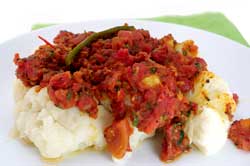 Quick
and easy, this incredibly flavorful sauce came together while the
cauliflower steamed. Using classic spice roasting techniques, the
kitchen fragrances abounded. The flavor layers built on one another
with the addition of garlic, ginger, and crushed tomatoes. The result
was a beautiful presentation and the tastiest cauliflower we've ever
had! Quick
and easy, this incredibly flavorful sauce came together while the
cauliflower steamed. Using classic spice roasting techniques, the
kitchen fragrances abounded. The flavor layers built on one another
with the addition of garlic, ginger, and crushed tomatoes. The result
was a beautiful presentation and the tastiest cauliflower we've ever
had!
Click here to view the full, illustrated recipe.
Click here for a printable version of the recipe.
Everyday Yellow Dal
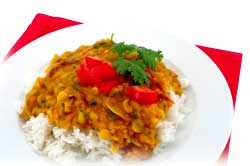 High
protein, inexpensive and marvelously delicious, this yellow dal
deserves to be a regular in your repertoire! Spices are bloomed in hot
oil, and a savory mixture created with the addition of plenty of onions
and garlic. Traditional flavors are showcased well in this satisfying
mélange of color and taste. Next time we plan to try our pressure
cooker so that the soaking step is eliminated and the cooking time cut
to one-third the time. High
protein, inexpensive and marvelously delicious, this yellow dal
deserves to be a regular in your repertoire! Spices are bloomed in hot
oil, and a savory mixture created with the addition of plenty of onions
and garlic. Traditional flavors are showcased well in this satisfying
mélange of color and taste. Next time we plan to try our pressure
cooker so that the soaking step is eliminated and the cooking time cut
to one-third the time.
Click here to view the full, illustrated recipe.
Click here for a printable version of the recipe.
Goan Shrimp Curry with Eggplant
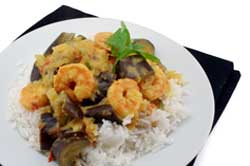 The
featured spices rearranged for this curry were enhanced with the
addition of coconut milk. This recipe has its roots in the coastal Goa
region of western India where seafood dishes are the natural cuisine.
Once again, the tantalizing flavors dazzled our taste buds and more
than satisfied our hunger. With a one skillet preparation the dish came
together in less than one-half hour. This recipe would be equally good
with any number of vegetables. Another keeper for the quick supper
repertoire! The
featured spices rearranged for this curry were enhanced with the
addition of coconut milk. This recipe has its roots in the coastal Goa
region of western India where seafood dishes are the natural cuisine.
Once again, the tantalizing flavors dazzled our taste buds and more
than satisfied our hunger. With a one skillet preparation the dish came
together in less than one-half hour. This recipe would be equally good
with any number of vegetables. Another keeper for the quick supper
repertoire!
.
Click here to view the full, illustrated recipe.
Click here for a printable version of the recipe.
|
 |
Go global in your kitchen -- it's worth the trip!
|
|
Lorraine, Katie, and all of the Staff at Beyond Pots and Pans
|
|
|
|
|